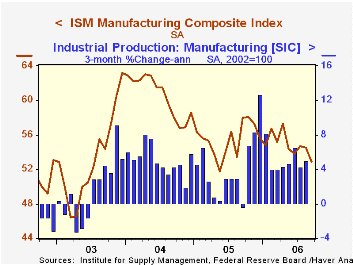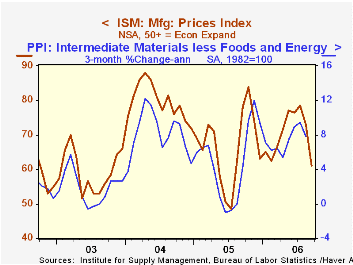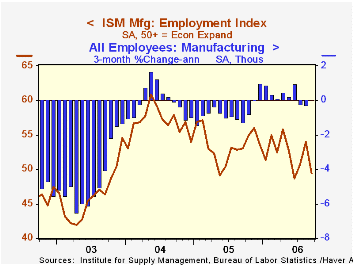 Global| Oct 02 2006
Global| Oct 02 2006ISM Composite & Price Indexes Down
by:Tom Moeller
|in:Economy in Brief
Summary
The September composite index of manufacturing sector activity from the Institute for Supply Management fell to 52.9 from 54.5 during the prior month. The decline was the fourth in the last five months and left the index down five [...]

The September composite index of manufacturing sector activity from the Institute for Supply Management fell to 52.9 from 54.5 during the prior month. The decline was the fourth in the last five months and left the index down five points from the year ago peak of 58.1 Consensus expectations had been for a more moderate decline m/m to 53.5.
During the last ten years there has been a 67% correlation between the level of the ISM index and three month growth in factory sector industrial production.
At 61.0 the price index, which is not included in the composite, dropped to its lowest level since last November. During the last ten years there has been an 89% correlation between the level of the price index and the three month change in the PPI for intermediate goods less food & energy.
The percentage of respondents reporting higher prices fell to its lowest level (36%) since February.
A lower employment component, which fell to 49.4 from a four month high of 54.0 in August, accounted for much of the m/m decline in the composite. During the last ten years there has been a 77% correlation between the level of the ISM employment Index and the three month growth in factory sector employment.
The inventories index also fell sharply m/m while all of the other component series fell modestly with the exception of new orders which was unchanged m/m. The new orders index, however, at 54.2 is down sharply from the December 2003 high of 71.6.
The new export orders index fell modestly m/m to 55.3 and is down roughly three points from the recent high in January of 58.5. The series peak was in early 2004 near 60. During the last ten years there has been a 69% correlation between the level of the export order index and the q/q growth in goods exports from the GDP accounts. The imports index rose back to the middle of its range since early 2005.
Explaining Cyclical Movements in Employment: Creative Destruction or Changes in Utilization from the Board of Governors of the Federal Reserve System is available here.
Economic Revitalization Through the Arts: The Creative Economy from the Federal Reserve Bank of Boston can be found here.
| ISM Manufacturing Survey | September | August | Sept. '05 | 2005 | 2004 | 2003 |
|---|---|---|---|---|---|---|
| Composite Index | 52.9 | 54.5 | 58.0 | 55.5 | 60.5 | 53.3 |
| Prices Index (NSA) | 61.0 | 73.0 | 78.0 | 66.4 | 79.8 | 59.6 |
Tom Moeller
AuthorMore in Author Profile »Prior to joining Haver Analytics in 2000, Mr. Moeller worked as the Economist at Chancellor Capital Management from 1985 to 1999. There, he developed comprehensive economic forecasts and interpreted economic data for equity and fixed income portfolio managers. Also at Chancellor, Mr. Moeller worked as an equity analyst and was responsible for researching and rating companies in the economically sensitive automobile and housing industries for investment in Chancellor’s equity portfolio. Prior to joining Chancellor, Mr. Moeller was an Economist at Citibank from 1979 to 1984. He also analyzed pricing behavior in the metals industry for the Council on Wage and Price Stability in Washington, D.C. In 1999, Mr. Moeller received the award for most accurate forecast from the Forecasters' Club of New York. From 1990 to 1992 he was President of the New York Association for Business Economists. Mr. Moeller earned an M.B.A. in Finance from Fordham University, where he graduated in 1987. He holds a Bachelor of Arts in Economics from George Washington University.






